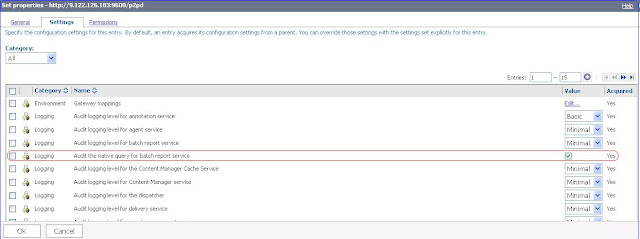The IBM Cognos 10.2 supports following 'run with options' report output formats-
-HTML
-PDF
-Excel 2007
-Excel 2007 Data
-Excel 2002
-Delimited text (CSV)
-XML
Step 01) Look for 'system.xml' file present at IBM Cognos install path. It can be found at
<C10>\templates\ps location.
Step 02) Open 'system.xml' file in editor. And search for supported report output formats as shown below-
<!-- Supported report output formats -->
<param name="reportFormats">
<format id="HTML" browserHide="" appMode="basic adv rv"/>
<format id="XHTML" browserHide="" appMode="adv"/>
<format id="HTMLFragment" browserHide="" downloadable="false" appMode="adv"/>
<format id="PDF" browserHide="" downloadable="true" appMode="basic adv rv" extension="pdf">
<format id="spreadsheetML" browserHide="safari" downloadable="true" appMode="basic adv rv" extension="xlsx"/> <!-- excel 2007 format -->
<format id="xlsxData" browserHide="safari" downloadable="true" appMode="basic adv rv" extension="xlsx" /> <!-- excel 2007 data -->
<format id="XLWA" browserHide="safari" downloadable="true" appMode="basic adv rv" extension="xls" mime="application/vnd.ms-excel"/> <!-- excel 2002 format -->
<format id="singleXLS" browserHide="safari" downloadable="true" appMode="" extension="xls"/>
<format id="XLS" browserHide="safari moz other" downloadable="false" appMode="" cafaction="true"/>
<format id="CSV" browserHide="" downloadable="true" appMode="basic adv rv" extension="csv"/>
<format id="XML" browserHide="" downloadable="true" appMode="basic adv rv" extension="xml"/>
</param>
Step 03) In order to disable or hide the report output format not required by user, comment the particular 'format id' in step 02. There are 07 possible report output formats available with IBM Cognos 10.2 'run with options' drop down button.
Step 04) Restart the IBM Cognos BI server so that the changes made in the 'system.xml' file get reflected.
-HTML
-Excel 2007
-Excel 2007 Data
-Excel 2002
-Delimited text (CSV)
-XML
Step 01) Look for 'system.xml' file present at IBM Cognos install path. It can be found at
<C10>\templates\ps location.
Step 02) Open 'system.xml' file in editor. And search for supported report output formats as shown below-
<!-- Supported report output formats -->
<param name="reportFormats">
<format id="HTML" browserHide="" appMode="basic adv rv"/>
<format id="XHTML" browserHide="" appMode="adv"/>
<format id="HTMLFragment" browserHide="" downloadable="false" appMode="adv"/>
<format id="PDF" browserHide="" downloadable="true" appMode="basic adv rv" extension="pdf">
<format id="spreadsheetML" browserHide="safari" downloadable="true" appMode="basic adv rv" extension="xlsx"/> <!-- excel 2007 format -->
<format id="xlsxData" browserHide="safari" downloadable="true" appMode="basic adv rv" extension="xlsx" /> <!-- excel 2007 data -->
<format id="XLWA" browserHide="safari" downloadable="true" appMode="basic adv rv" extension="xls" mime="application/vnd.ms-excel"/> <!-- excel 2002 format -->
<format id="singleXLS" browserHide="safari" downloadable="true" appMode="" extension="xls"/>
<format id="XLS" browserHide="safari moz other" downloadable="false" appMode="" cafaction="true"/>
<format id="CSV" browserHide="" downloadable="true" appMode="basic adv rv" extension="csv"/>
<format id="XML" browserHide="" downloadable="true" appMode="basic adv rv" extension="xml"/>
</param>
Step 03) In order to disable or hide the report output format not required by user, comment the particular 'format id' in step 02. There are 07 possible report output formats available with IBM Cognos 10.2 'run with options' drop down button.
Step 04) Restart the IBM Cognos BI server so that the changes made in the 'system.xml' file get reflected.


































